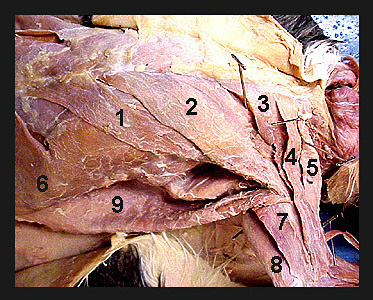|
|
|
|
||||||||||||||||||||||||||||||||||||||||||||||||||||||||||||||||||||||||||||
|
This image shows a ventral view of the superficial muscles of the cat chest. The chest muscles form a large, triangular mass of muscles collectively called the pectoral group. These muscles originate on the sternum and insert on or near the humerus. The major action of these muscles is adduction of the forelimb (i.e. the front leg is drawn toward the midline). There are four subdivisions of the pectoral group in the cat. The pectoantebrachialis is the most superficial muscle of the pectoral group. It is comprised of a narrow, thin band of parallel fibers which run from the anterior end of the sternum to the fascia at the proximal end of the antebrachium (forearm). Deep to the pectoantebrachialis is the pectoralis major. Immediately posterior to the pectoralis major lies the pectoralis minor. In the cat the pectoralis minor is a larger and thicker muscle than is the pectoralis major. The fourth subdivision of the pectoral group, the xiphihumeralis, arises from the xiphoid process of the sternum posterior to the pectoralis minor. The xiphihumeralis is a thin band of muscle which runs lateral to the pectoralis minor and inserts on the proximal end of the humerus. Note that there is significant overlap of these muscles with one another. In other words, part of the pectoralis major is covered by the pectoantebrachialis and part of the pectoralis minor is covered by the pectoralis major. |
|
